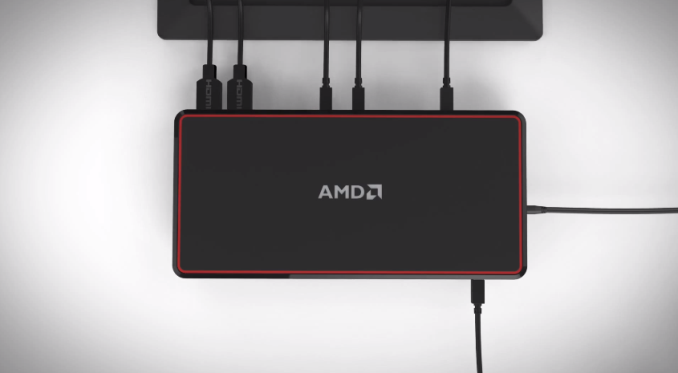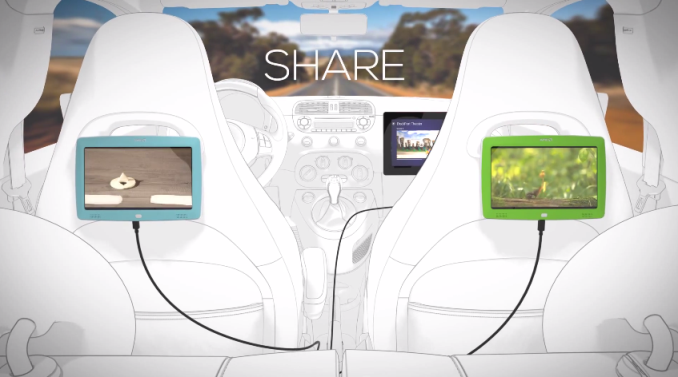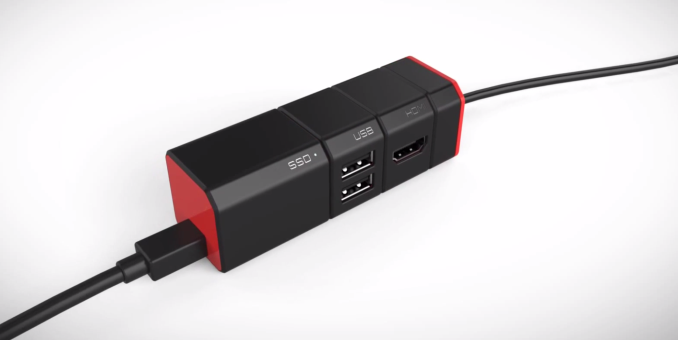AMD’s DockPort Given Virtual Overview
by Ian Cutress on February 13, 2014 4:58 AM EST- Posted in
- AMD
- DisplayPort
- DockPort

Flying somewhat under the radar, DockPort from AMD is designed to be a low-cost all-in-one solution for external connectivity for a PC or tablet. Sound familiar? Like Thunderbolt familiar? This is AMD’s solution to the issue of connectivity, using the DisplayPort connector to transfer USB information as well as audio/visual.
Not a lot has been said about DockPort, despite originally being given a name sometime in 2012, but since CES 2014 has been adopted as an official DisplayPort standard extension by VESA with a finalized standard expected in Q2. With the combination of DisplayPort and USB 3.0 over a single cable, AMD’s video explains it best how it can be used:
To list the possible uses:
- Charging (over USB 3.0 standard we would assume)
- Docking to an external keyboard/battery/audio
- Connecting Storage, Audio outputs, Video outputs, USB hubs
- Share video or run multiple video screens
Basically this is everything USB can do, including video stream via DisplayPort, albeit in a single interface that is already standard across many systems and form factors. AMD have not specified what extra hardware is needed beyond DisplayPort compatibility (presumably the next iteration of the DisplayPort standard) or whether this extension is just for limited use with a bridge chip. DockPort verified cables will be needed, and no idea on the cost of those this early in the development cycle, or whether the standard will be roped into DisplayPort fundamentally. The main competition is of course with Intel's Thunderbolt, where one of the features I am most looking forward to is Graphics over TB. That will not be possible with DockPort, but it will try to do everything else it seems, although it does seem to suggest that DockPort will be limited to USB 3.0 for any data-related daisy chaining, unless AMD have an ace up their sleeve.
I would imagine AMD would tie this technology into their desktop motherboard line, as well as their SoCs, when it is ready which might increase adoption rates faster than Thunderbolt. Having both interfaces use a similar sort of connector asks the question whether the two interfaces might be coherent in the same output/input, making future devices (namely storage) able to use both in one connector rather than have specific DockPort/TB inputs.
This is still early days, given the computer generated nature of AMD’s video. Computex is still several months away – we might see an real world update then. Looking forward to it…!


















52 Comments
View All Comments
schizoide - Thursday, February 13, 2014 - link
I can't speak to 1, although I'm sure you're right.But for 2, I would not expect a portable solution. I just want a docking station that can fit a competitive mid-range GPU. Huge power brick is A-OK. And really, pricing at $300 would be OK too.
BMNify - Thursday, February 13, 2014 - link
well there are existing External Single PCI Express Enclosure's like the http://www.netstor.com.tw/_03/03_02.php?OTk but you wont want to pay the costs for just a box and a card ....http://www.scan.co.uk/products/netstor-na221a-nb-p... £314.40 Inc VAT
schizoide - Thursday, February 13, 2014 - link
Yes, expresscard solutions exist, but they aren't very good. Not enough bandwidth. Needs to be thunderbolt or another similar pcie channel extension like SATA express.Also, 315 pounds sterling is >$500. That's a lot of frickin' money. Needs to be cheaper. What I really want is the following, for roughly $300:
1 double-width PCI-e slot with at least 4 pcie channels (8 would be better)
4 USB3 ports
1 headphone jack
1 optical audio jack
1 daisy-chain port (SATA express, thunderbolt, etc, whatever it uses)
Whoever delivers this product will make a crapton of money.
SirKnobsworth - Friday, February 14, 2014 - link
I doubt that if that is ever available it will cost that little. Each TB controller only has 4 PCIe lanes, which means this device would need to have a PLX chip for additional PCIe switching. Those aren't particularly cheap. And that's on top of an audio interface, a USB3 controller, and a power supply which can power a desktop graphics card.lmcd - Saturday, February 15, 2014 - link
Yeah the whole point is for an ULP by day, gaming PC by night. Accompany a ULV Haswell/Broadwell, and give the thing huge thermal headroom for its CPU cores when plugging in the dGPU (so no bottlenecking).MrSpadge - Thursday, February 13, 2014 - link
You're right - USB3. Which is too slow for GPUs. For pretty much anything else it's fine.And you're after console level graphics? The current IGPs already surpass PS3 and XB360. Overtaking the new ones will take a few more years, though.
Flunk - Friday, February 14, 2014 - link
PS3 and Xbox 360 both use IGPs and they're over 7 years old at this point. PC IGPs that surpass their performance are not impressive, we could have had that sort of performance 7 years ago if the manufacturers had wanted to put it out.lmcd - Saturday, February 15, 2014 - link
They were not iGPUs to start, and even now the PS3 GPU is on a separate die.winterspan - Thursday, February 13, 2014 - link
It's more complicated than that. The first version of thunderbolt wasn't even close to fast enough for a decent GPU. TB 2.0 (20gbps) is definitely closer, but it would still constrain a high end GPU. It also requires a special driver to be developed for OSX and windows. I'm sure you'll see a commercial version soon of the prototypes that have been seen out there.I had an expresscard->PCIe box with an ATI 3770 back in the day. It worked adequately, but could be really flaky. Also if the express card got unplugged the system would immediately crash (probably unavoidable)
That said, i would pay top dollar for a reliable thunderbolt based GPU for my MacBook Air (even if it can only support a midrange GPU until TB 3.0) and it would be particularly awesome if it worked with windows.
R3MF - Thursday, February 13, 2014 - link
this needs to be a thing.royalty free for widespread adoption, and the addition of power, have the potential to be a brilliant addition to all motherboards/tablet devices.